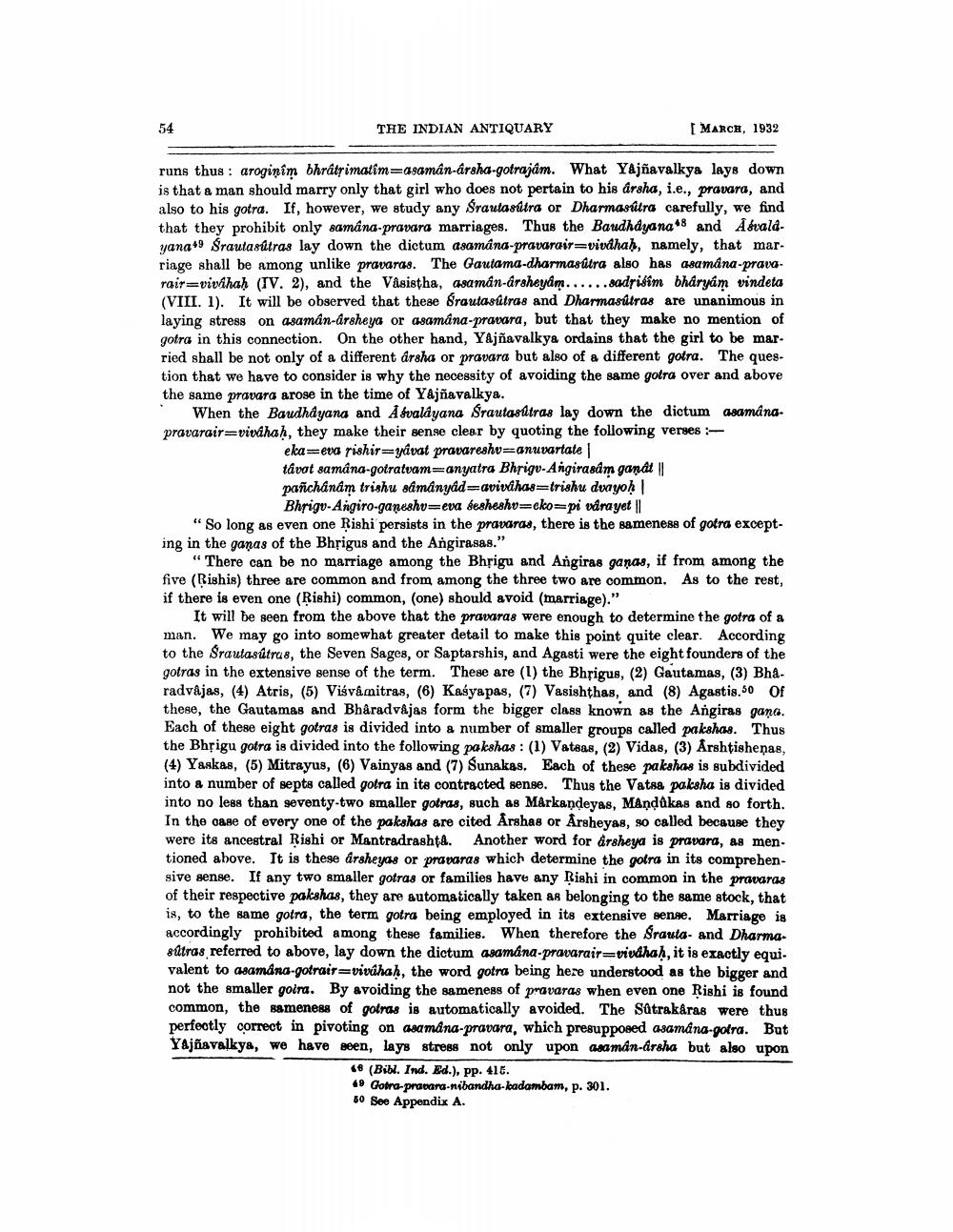________________
54
THE INDIAN ANTIQUARY
I MARCH, 1932
runs thus: aroginim bhrátsimatim=asamán-arsha-gotrajám. What Yajñavalkya lays down is that a man should marry only that girl who does not pertain to his arsha, i.e., pravara, and also to his gotra. If, however, we study any Srautasútra or Dharmasútra carefully, we find that they prohibit only samana-pravara marriages. Thus the Baudhdyana*8 and Advala. yana+9 Srautasútras lay down the dictum asamâna-pravarair=vivdhah, namely, that marriage shall be among unlike pravaras. The Gautama-dharmasútra also has asamâna-pravarair=vivihah (IV. 2), and the Våsistha, asamán-ársheyam......sadrisim bháryám vindeta (VIII. 1). It will be observed that these Srautasútras and Dharmasútras are unanimous in laying stress on asamán-arsheya or asamána-pravara, but that they make no mention of gotra in this connection. On the other hand, Yajñavalkya ordains that the girl to be mar. ried shall be not only of a different arsha or pravara but also of a different gotra. The ques. tion that we have to consider is why the necessity of avoiding the same gotra over and above the same pravara arose in the time of Yajñavalkya.
When the Baudhayang and Afvaldyana Srautasutras lay down the dictum asamánapravarair=viváhah, they make their sense clear by quoting the following verses
eka=eva pishir=yávat pravareshu=anuvartate tavat samana-gotratvam=anyatra Bhrigu-Angirasdm gandt | pañchanam trishu sámányád=avivihas-trishu duayoh
Bhrigu-Angiro-ganeshu=eva desheshu=ckorpi vdrayet II "So long as even one Rishi persists in the pravaras, there is the sameness of gotra excepting in the ganas of the Bhrigus and the Angirasas."
"There can be no marriage among the Bhrigu and Angiras ganas, if from among the five (Rishis) three are common and from among the three two are common. As to the rest, if there is even one (Rishi) common, (one) should avoid (marriage)."
It will be seen from the above that the pravaras were enough to determine the gotra of a man. We may go into somewhat greater detail to make this point quite clear. According to the Srautasútrus, the Seven Sages, or Saptarshis, and Agasti were the eight founders of the gotras in the extensive sense of the term. These are (1) the Bhrigus, (2) Gautamas, (3) Bha. radvâjas, (4) Atris, (5) Visvamitras, (6) Kasya pas, (7) Vasishthas, and (8) Agastis.50 Of these, the Gautamas and Bharadvajas form the bigger class known as the Angiras gana. Each of these eight gotras is divided into a number of smaller groups called pakshas. Thus the Bhrigu gotra is divided into the following pakshas : (1) Vatsas, (2) Vidas, (3) Arshtishenas, (4) Yaskas, (5) Mitrayus, (6) Vainyas and (7) Sunakas. Each of these pakshas is subdivided into a number of septs called gotra in its contracted sense. Thus the Vatsa paksha is divided into no less than seventy-two smaller gotras, such as Markandeyas, Mandukas and so forth. In the case of every one of the pakshas are cited Arshas or Årsheyag, so called because they were its ancestral Rishi or Mantradrashta. Another word for arsheya is pravara, as mentioned above. It is these arsheyas or pravaras which determine the gotra in its comprehensive sense. If any two smaller gotras or families have any Rishi in common in the pravaras of their respective pakshas, they are automatically taken as belonging to the same stock, that is, to the same gotra, the term gotra being employed in its extensive senge. Marriage is accordingly prohibited among these families. When therefore the Srauta- and Dharmasutras referred to above, lay down the dictum asamána-pravarair=vivdhah, it is exactly equi. valent to asamána-gotrair=viváhah, the word gotna being here understood as the bigger and not the smaller goira. By avoiding the sameness of pravaras when even one Rishi is found common, the sameness of gotras is automatically avoided. The Sätrakaras were thus perfectly correct in pivoting on asamâna-pravara, which presupposed asama na potra. But Yajñavalkya, we have seen, lays stress not only upon asaman-arsha but also upon
6 (Bibl. Ind. Ed.), pp. 416. 49 Gotra-pracara-nibandha-kadambam, p. 301. 50 See Appendix A.




